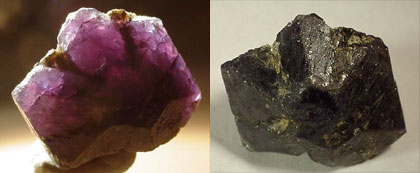Birthstones by the Month
One of the June Birthstones is Alexandrite

Step Cut Alexandrite Cushion
Alexandrite Cushion, 26.75 cts. Bluish green in daylight and purple red under incandescent light, alexandrites this large are extremely rare. [1]
Alexandrite Mineral Form
Alexandrite is considered a chrysoberyl, though it differs from other chrysoberyls because it contains contrasting chemical characteristics. Typically, beryllium and chromium do not naturally occur together, yet in Alexandrite both are present.
Lastly, an absence of silica (the second most common chemical element found in the Earth’s crust) is necessary to prevent the mineral from growing into an emerald. It is this combination which results in Alexandrite actually changing color depending on light source.

Natural Alexandrite
Another beautiful example of a natural crystal of the June birthstone. This is a very transparent green specimen found in Brazil. [2]
Alexandrite Facts
A rare gemstone originally discovered in Russia during the early 1800s, Alexandrite was named in honor of Alexander Nicholavich who later became the Russian Czar Alexander II. Since Alexandrite contained the same colors as the imperial colors, this gemstone became official gemstone of Czarist Russia. Alexandrite As mines were depleted in Russia and families held onto their Alexandrite, interest in this gemstone waned. In the late 1900s however, the discovery of Alexandrite in Brazil dramatically increased Alexandrite’s appeal again. Alexandrite has now also been found in Sri Lanka (though in far less favorable quality), Tanzania, India, Burma, Madagascar and Zimbabwe.
The characteristics of Alexandrite
Alexandrite changes in color depending on what light source the gemstone is under. When in daylight, Alexandrite takes on a blue-green coloration and when placed under artificial, or incandescent, light, the gemstone changes to more of a purple-red hue. Alexandrite has a Mohs hardness of 8.5 making it an easy gemstone to design with as it will not easily scratch or crack.

Color Changing Variety Alexandrite
Alexandrite crystal in daylight on the left and fluorescent light on the right. The specimen is from Brazil. The color changing variety Alexandrite is highly valued. [3]
Cut and Clarity for the June birthstone
When viewed at different angles, Alexandrite exhibits different color intensities, known as a pleochroic gemstone. Gem cutters must take note of which angles produce the brightest shine when cutting. Alexandrite is therefore most often cut into what is referenced as mixed cuts with brilliant-cut crowns and step-cut pavilions.
Chatoyancy in Alexandrite is incredibly rare, but it does exist. Chatoyant Alexandrite is cut into a cabochon to maximize the cat eye reflection. While Alexandrite typically does not display inclusions, the few that do exist do not often detract from the appearance to the naked eye.

Alexandrite Sixling
A very good, nearly complete, sixling. The luster and color are excellent with transmitted light. [4] [5]
The value of Alexandrite
As with most gemstones, the more vivid the color of Alexandrite, the more valuable the stone becomes. In addition, Alexandrite with a more distinct color change is worth a great deal more than more subtle differences. High grade Alexandrite will not display the undesirable traces of brown or grey. If an Alexandrite is able to be traced back to Russia, price also drastically increases as these were the original and are rarer than other deposits today. Due to the scarcity of necessary mineral formations, Alexandrite is an uncommon stone, which also increases its value. In fact, Alexandrite with fine facets above one carat are actually more expensive than fine ruby, sapphire or emerald do to its rarity.

Chrysoberyl Variant of Alexandrite
This is a classic sixling twin of Alexandrite, complete all around. Not only does it have excellent form, but you can see the green of artificial light and the red of transmitted light. [6] [7]
Is Alexandrite ever treated?
It is uncommon to treat Alexandrite, though it is possible to find the gemstone with fissure-filling oil treatments.
More about Alexandrite the June birthstone
Alexandrite is a rare gemstone and is commonly grown synthetically. Often these stones are actually color-changing sapphires colored with the element vanadium or synthetic spinel.
The American Gem Society's June Birthstone page has more information to help you buy from knowledgeable and skilled jewelers and to help you make the most informed buying decision.
Image Attribution
- By User: at en.wikipedia [GFDL or CC-BY-SA-3.0], from Wikimedia Commons
- By Yaiba Sakaguchi (https://www.mindat.org/photo-357005.html) [Public domain], via Wikimedia Commons
- By Vzb83 (Own work) [GFDL, CC-BY-SA-3.0 or CC BY-SA 2.5-2.0-1.0], via Wikimedia Commons
- Rob Lavinsky, iRocks.com – CC-BY-SA-3.0 [CC BY-SA 3.0], via Wikimedia Commons
- Rob Lavinsky, iRocks.com – CC-BY-SA-3.0 [CC BY-SA 3.0], via Wikimedia Commons
- Rob Lavinsky, iRocks.com – CC-BY-SA-3.0 [CC BY-SA 3.0], via Wikimedia Commons
- Rob Lavinsky, iRocks.com – CC-BY-SA-3.0 [CC BY-SA 3.0], via Wikimedia Commons